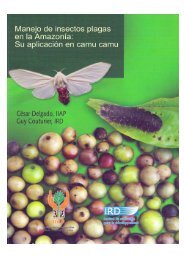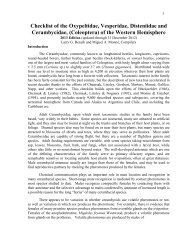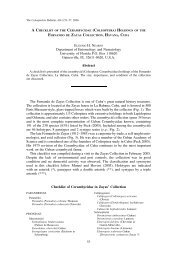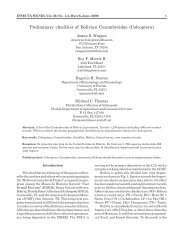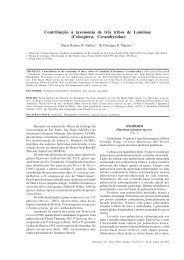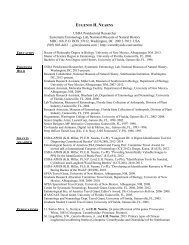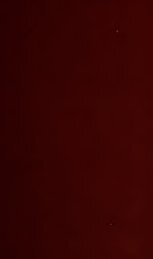Create successful ePaper yourself
Turn your PDF publications into a flip-book with our unique Google optimized e-Paper software.
Introduction<br />
Xlll<br />
Pronotum not cylindrical, conical or nearly so, distinctly narrower apically than<br />
at base; front rather narrow, usually much narrower between eyes .... . 49<br />
49. Pronotum unarmed laterally, sides regularly tapering from base to apex; elytra<br />
with basal gibbosities prominent . . ... .... .. ... . . . . . . . 1Iypsioma (p. 18)<br />
Pronotum tuberculate laterally, sides wider behind middle than basally, then<br />
narrowed to apex; elytra with basal gibbosities not prominent<br />
Cipn.,scoia (p. 82)<br />
50. Antennae with third segment bisinuate . . ... . . . . . . .. . . ... . . Sulpitus (p. 139)<br />
Antennae with third segment straight ................ .... .............. 51<br />
51. Pronotum with sides swollen before and behind middle . . . . . . . . Lochmaeocles<br />
Pronotum cylindrical, sides not swollen . . . . ... . . ... . ... . . . . . . . . lschiocentra<br />
52. Antennae with third segment straight or arcuate ........... ..... .. ....... 53<br />
Antennae with third segment bisinuate ..... . ............... .... .. . ..... 61<br />
53. Pronotum conical, sides strongly narrowed from base to apex . . Lachllia (p.11)<br />
Pronotum not conical, sides not regularly narrowed ..... ................. 55<br />
54. Antennae with third segment arcuate, scape slender, very gradually clFate<br />
from base . . . . . . ... . . ... . . . . . . . ... ... . . . .... . ... Typhlocerus (p. 117)<br />
Antennae with third segment bisinuate, scape strongly capitate on apical half<br />
Truncatoides (p. 16)<br />
55. Pronotum with sides swollen before and behind middle ....... ............ 56<br />
Pronotum more or less cylindrical, sides not as above ...... ..... . .. 57<br />
56. Pronotum unarmed laterally, disk wit.hout tubercles; antennal tubercles with<br />
horns directed vertically; prosternum without a median transverse process;<br />
eye with lower lobe twice genal height (Genotype: Hesycha crctacca<br />
Bates) . .... . . .... . . ............. ............ ....... Ephia1es, n. g.<br />
Pronotum tuberculate laterally and on disk; antennal tubercles with horns<br />
dirc-cted forward; prosternum with a transverse process; eye with lower<br />
lobe slightly longer than gena . .... . . . . . .......... Lochmaeocles<br />
57. Antennae with fifth, sixt.h, and seventh segments each longer than fourth<br />
Ischioderes (p. 184)<br />
Antennae with fifth and following segments (except eleventh sometimes) shorter<br />
than fourth . . . . . . . . . . . . . . . . . . . . . . . . . . . . . . . . . . . . . . . . . . . . . . . . . . . . . . 58<br />
58. Antennae with scape only attaining or feebly surpassing apical margin of<br />
pronotum . . . . ........................................... Trestonia<br />
Antennae with scape attaining at least apical quarter of pronotum ........ 59<br />
59. Pronotum unarmed laterally ............... ............. ... ... ... ... ... 60<br />
Pronotum at least feebly armed laterally behind middle ......... lschiocemra<br />
60. Pronotum with disk rugose; clytra with a transverse black macula at apical<br />
quarter . ... . ......................................... Apocoptoma<br />
Pronotum with disk punctate; elytra without black maculae . . . . . . . . Cacostola<br />
61. Pronotum with sides deeply impressed or excavated . . . . . . . . Midamus (p. 141)<br />
Pronotum with sides not impressed or excayated ............... ..... ... 62<br />
62. Pronotum unarmed at sides ... ........ .......... ........ .............. 65<br />
Pronotum at least feebly armed Iterally behind middle ................. 63<br />
63. Front narrow, distinctly narrower between eyes, expanded to lower margin of<br />
eyes, thence sides nearly parallel to mouth; tarsi with claw segments pale<br />
at base .. . . . ... ... . . ... ...... ... ... . . . . .. ..... . . . . Charoides (p. 55)



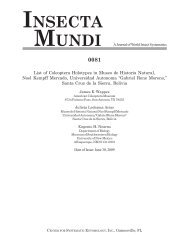
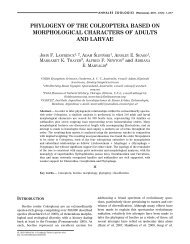


![Coleoptera. Vol. I. [Longicornia. Part I.]](https://img.yumpu.com/41202793/1/180x260/coleoptera-vol-i-longicornia-part-i.jpg?quality=85)
